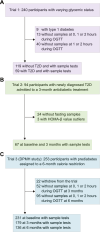Association Between Circulating Gremlin 2 and β-Cell Function Among Participants With Prediabetes and Type 2 Diabetes
- PMID: 40270326
- PMCID: PMC12018890
- DOI: 10.1111/1753-0407.70090
Association Between Circulating Gremlin 2 and β-Cell Function Among Participants With Prediabetes and Type 2 Diabetes
Abstract
Aim: Circulating Gremlin 2 (Grem2) has recently been linked to human obesity, but its role in type 2 diabetes (T2D) remains unclear. This study aims to explore the association of circulating Grem2 with β-cell function.
Methods: A post hoc analysis was conducted using data from three clinical trials, in which all participants underwent the oral glucose tolerance test (OGTT). Circulating Grem2 levels were measured at 0, 1, and 2 h during the OGTT. In Trial 1, Grem2 levels were compared between participants with T2D (n = 59) and without T2D (n = 119). We further examined changes in Grem2 levels in response to oral antidiabetic drugs in participants with T2D in Trial 2 (n = 67) and calorie restriction in participants with prediabetes in Trial 3 (n = 231). The relationship between Grem2 levels and β-cell function was analyzed across all trials.
Results: Fasting and 1-h Grem2 levels were lower in participants with T2D compared with those without T2D (728 ± 25 vs. 649 ± 31 pg/mL, p = 0.020; 631 ± 26 vs. 537 ± 31 pg/mL, p = 0.007). Fasting Grem2 levels were restored after antidiabetic treatment (550 ± 12 vs. 575 ± 12 pg/mL, p = 0.019), and 1-h Grem2 levels increased following calorie restriction (1118 ± 89 vs. 1144 ± 90 vs. 1253 ± 89 pg/mL, p for trend = 0.002). The 1-h Grem2 levels were positively associated with β-cell function assessed by the oral disposition index and HOMA-β.
Conclusion: Reduced circulating Grem2 levels are associated with impaired β-cell function in T2D, and could be restored through antidiabetic interventions.
Trial registration: ClinicalTrials.gov: NCT01959984, NCT01758471, NCT03856762.
Keywords: Gremlin 2; calorie restriction; oral antidiabetic drug; prediabetes; type 2 diabetes; β‐cell function.
© 2025 The Author(s). Journal of Diabetes published by Ruijin Hospital, Shanghai JiaoTong University School of Medicine and John Wiley & Sons Australia, Ltd.
Conflict of interest statement
The authors declare no conflicts of interest.
Figures




References
Publication types
MeSH terms
Substances
Associated data
Grants and funding
LinkOut - more resources
Full Text Sources
Medical

